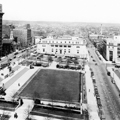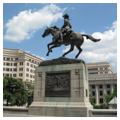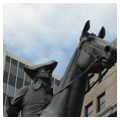Occupying the hilltop at the center of downtown, the park called Rodney Square was intended to take the adjoining Public Building, the DuPont Building, and a planned library and “unify them into a single scheme of civic adornment.” A million-gallon water reservoir (1827–1877) originally occupied this site, which was replaced by the New Castle County Courthouse (1880, Theophilus P. Chandler; demolished 1919–1920). The subsequent courthouse would have stood here, too, except that John J. Raskob of the DuPont Company wisely suggested placing it farther east in order to create a square. With funds from Irénée du Pont, a Center Square competition was held in 1916–1917 by the Park Commission, conducted by University of Pennsylvania professor Warren P. Laird, who was assisted by a board of experts, including architects William M. Kendall, Charles A. Platt, and John Russell Pope. This kind of professional, nonpolitical jury was typical of the reformist City Beautiful movement of the early twentieth century. Of the five plans submitted (including one by Carrère and Hastings), that of the Zantzinger firm of Philadelphia had, according to the judges, “the requisite simplicity and dignity.” The winners worked with the Onondaga Litholite Company of Syracuse, New York, suppliers of the cut cast stone. Bronze lanterns on pylons were illuminated by electric lights. From the time of its completion, the square has been a favorite gathering place, and 30,000 people assembled here to cheer pro-business Republican presidential candidate Wendell Wilkie in October 1940. Rodney Square had its pavements redesigned in the 1970s and again in 1996–1997 (Rodney Robinson).
You are here
Rodney Square
1917–1921, Zantzinger, Borie and Medary. East side of Market St., between 10th and 11th sts.
If SAH Archipedia has been useful to you, please consider supporting it.
SAH Archipedia tells the story of the United States through its buildings, landscapes, and cities. This freely available resource empowers the public with authoritative knowledge that deepens their understanding and appreciation of the built environment. But the Society of Architectural Historians, which created SAH Archipedia with University of Virginia Press, needs your support to maintain the high-caliber research, writing, photography, cartography, editing, design, and programming that make SAH Archipedia a trusted online resource available to all who value the history of place, heritage tourism, and learning.









